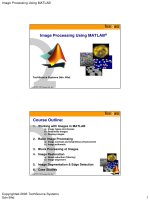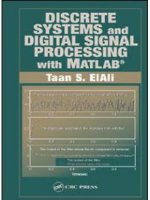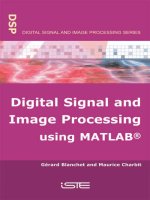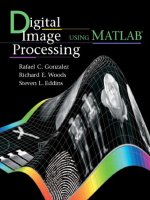Digital image processing using MATLAB ZERO to HERO practical approach
Bạn đang xem bản rút gọn của tài liệu. Xem và tải ngay bản đầy đủ của tài liệu tại đây (28.14 MB, 253 trang )
ZERO
TO
HERO
DIGITAL IMAGE PROCESSING USING
MATLAB
ZERO TO HERO
DIGITAL IMAGE PROCESSING USING
MATLAB
A RSATH N ATHEEM S
Copyright © 2017, 2018 by futurebme.com
WHY I WROTE THIS BOOK
I wrote this book because Image processing is fresh and interesting
topic for Research work. This book is all about that how to develop theory
and project based notion about Image processing. This book contain plenty of
programming illustration that are analyzed can also be beneficial for learners
and under graduates pupils. This book starts from very basic Knowledge and
gradually cover all of the improvement topics of a Image processing with
MATLAB examples.
WHY YOU SHOULD READ THIS BOOK
his book will help you learn all about digital image processing
T
Importance, and necessity of image processing stems from application areas
the first being the Improvement of data for individual interpretation and the
second being that the Processing of a spectacle data for an machine
perception. Digital image processing includes a assortment of applications
such as remote sensing, image and information storage for transmission in
acoustic imaging, medical imaging, business applications , Forensic sciences
and industrial automation. Images are helpful in tracking of earth resources
mapping, and forecast of urban populations, agricultural crops, climate
forecasting, flooding and fire control. Space imaging applications include
comprehension and analyzation of objects contained in images obtained from
deep space-probe missions. There are also medical programs such as
processing of X-Rays, Ultrasonic scanning, Electron micrographs, Magnetic
Resonance Imaging, Nuclear Magnetic Resonance Imaging, etc.. In addition
to the aforementioned applications, digital image processing is being used to
solve a variety of issues. Even unrelated, these problems commonly require
methods effective at improving information. The Image processing
Procedures like restoration and Image enhancement are used to procedure
images that were degraded or blurred. Powerful uses of image processing
concepts are observed in defense astronomy, biology, medical and industrial
applications. As per Medical Imaging is concerned almost all of the pictures
could be utilized in the discovery of tumors or for viewing the patients. The
current key field of use of digital image processing (DIP) methods is in
solving the issue of machine vision so as to attain superior results
TABLE OF CONTENTS
CHAPTER
NO
1
2
3
4
5
6
7
8
TITLE
Introduction
Basic Morphological Operation
MATLAB program for dilation, erosion, opening, closing
and their properties step by step explanation
Image Segmentation
Thresholding
Region, Edge based segmentation
MATLAB Source Code for Image Segmentation
Output for Image Segmentation
Application, Conclusion
Intensity Transformation
Theoretical Concepts: Introduction
MATLAB program for Image Intensity Transformation
Histogram Equalization
Introduction:Practical approach
MATLAB Source Code for Histogram Equalization
Conclusion
Spatial Intensity Resolution
MATLAB Source Code For Spatial Intensity Resolution
Enhancement in Spatial Filter
MATLAB Source Code For Image Enhancement in Spatial
Filtering
Enhancement in Frequency Filter
MATLAB Source Code For Image Enhancement in
Frequency Filtering
Color Image Processing
MATLAB Source Code For Color Image Processing
9
10
11
12
DFT (Discrete Fourier Transform) Analysis
MATLAB Source Code For DFT Analysis
Basic Thresholding Function
MATLAB Source Code For Basic Thresholding Function
Sampling and Quantization
MATLAB Source Code For Sampling and Quantization
Image Transformation
MATLAB Source Code For Image Transformation
INTRODUCTION
What is MATLAB?
MATLAB = Matrix Laboratory
“MATLAB is a high-level language and interactive
environment that allows you to achieve computationally
intensive tasks faster than with old-style programming
languages like C, C++ and Fortran.” (www.mathworks.com)
MATLAB is an interactive, understood language that is
designed for fast numerical matrix calculations
MATLAB window components:
Workspace
Displays all the defined variables
Command Window
To perform commands in the MATLAB environment
Command History
Displays record of the commands used
File Editor Window
Define your functions
MATLAB Help
•
•
MATLAB Help is an very powerful assistance to learning MATLAB
Help not only contains the theoretic background, but also shows demos
for implementation
•
MATLAB Help can be unlocked by using the HELP pull-down menu
•
Some command description can be found by typing the command in
the search field
• As shown above, the command to take square root (SQRT) is
examined
•
We can also use MATLAB Help from the command window as shown
More about the Workspace
• who, whos – present variables in the workspace
• save – save workspace variables to *.mat file
•
•
load – load variables from *.mat file
clear – clear workspace variables
Matrices in MATLAB
Matrix is the main MATLAB data type
How to build a matrix?
➢ A=[1 2 3; 4 5 6; 7 8 9];
➢ Creates matrix A of size 3 x 3
Special matrices:
zeros(n,m), ones(n,m), eye(n,m), rand(), randn()
Numbers are always double (64 bits) unless you specify a
dissimilar data type
Basic Operations on Matrices
• All operators in MATLAB are defined on matrices: +, -, *, /, ^,
sqrt, sin, cos, etc.
•
•
•
Element-wise operators defined by a previous dot: .*, ./, .^
sum(A) – columns sums vector
size(A) – size vector
• sum(sum(A)) – sum of all the elements
Variable Name in Matlab
✓
Variable naming rules
- must be unique in the first 63 characters
- Necessity begin with a letter
- may not contain blank spaces or additional types of punctuation
- may contain any grouping of letters, digits, and underscores
- are case-sensitive
- should not use Matlab keyword
✓
Pre-defined variable names
pi
Logical Operators
• ==, <, >, (not equal) ~=, (not) ~
•
find(‘condition’) – Returns directories of A’s elements that
satisfy the condition
•
Example:
>>A=[7 3 5; 6 2 1], Idx=find(A<4)
A=
735
621
Idx=
3
4
6
Flow Control
MATLAB has five flow control concepts:
1. if statement
2. for loop
3. while loop
4. switch statement
5. break statement
Scripts and Functions
There are two kinds of M-files:
1. Scripts, which don’t accept input opinions or return
production arguments. They operate on data in the
workspace
2. Functions, which can accept input opinions and return
production arguments. Interior variables are local to the
function
•
Example:
A file called STAT.M:
function [mean, stdev]=stat(x)
%STAT Interesting statistics.
n=length(x);
mean=sum(x)/n;
stdev=sqrt(sum((x-mean).^2)/n);
Defines a novel function called STAT that computes the mean
and standard deviation of a vector. Function name and file name
should be the SAME!
Visualization and Graphics
•
plot(x,y),plot(x,sin(x)) – plot 1D function
•
•
•
figure, figure(k) – open a fresh figure
hold on, hold off – refreshing
axis([xmin xmax ymin ymax]) – change axes
•
•
title(‘figure titile’) – add title to figure
mesh(x_ax,y_ax,z_mat) – view surface
•
•
contour(z_mat) – view z as topo map
subplot(3,1,2) – find several plots in figure
Saving your Effort
Save mysession
creates mysession.mat with all variables
%
Save mysession a b
save only variables a and b
%
Clear all
% clear all variables
Clear a b
% clear variables a and b
Load my session
% load session
What is the Image Processing Toolbox?
•
The Image Processing Toolbox is a group of functions that extend the
abilities of the MATLAB’s numeric scheming environment. The
toolbox supports a wide range of image processing operations, together
with:
Image analysis and enhancement
Geometric operations
Linear filtering and filter design
Neighborhood and block operations
Transforms
Region of interest operations
Binary image operations
YOU CANNOT USE THE IMAGE PROCESSING TOOLBOX FOR
HOMEWORK OR FINAL PROJECT
Images in MATLAB
MATLAB can import/export some image formats:
JPEG (Joint Photographic Experts Group)
GIF (Graphics Interchange Files)
PNG (Portable Network Graphics)
TIFF (Tagged Image File Format)
BMP (Microsoft Windows Bitmap)
HDF (Hierarchical Data Format)
PCX (Paintbrush)
XWD (X Window Dump)
raw-data and other types of image data
Naturally switch images to double to achieve any processing
and convert back to unsigned integer
Data types in MATLAB
Single (32-bit single-precision floating point)
Double (64-bit double-precision floating point)
Int16 (16-bit signed integer)
Int32 (32-bit signed integer)
Int8 (8-bit signed integer)
Uint8 (8-bit unsigned integer)
Uint16 (16-bit unsigned integer)
Uint32 (32-bit unsigned integer)
Images in MATLAB
Image Import and Export
Read and write images in Matlab
img = imread('apple.jpg');
dim = size(img);
figure;
imshow(img);
imwrite(img, 'output.bmp', 'bmp');
lternatives to imshow
A
imagesc(I)
imtool(I)
image(I)
Image Display
•
•
imshow - display image
image - create and display image object
•
imagesc - scale and display as image
CHAPTER 1.
BASIC MORPHOLOGICAL OPERATION
Introduction
I mage Processing is a technique to perform some functions on an
image, in order to have an improved image or to extract various interesting
facts from it. Image Morphology is an essential tool in image processing. It is
actually the learn shapes of object present in the image and extraction of
image features. Image features are essential for object recognition. The basic
morphological operations include Erosion and Dilation, Opening and Closing
are also morphological operators. These operators are deciding on as basic
operations in image processing algorithms.
DILATION
Dilation operator can be used to binary and grey scale images. The
purpose of this operator is to expand the window and shrinks background. It
slowly increases the boundaries of the region, while the small holes existing
in the image become smaller. It increases the illumination of the object.
Fig.1.Example: Dilation
Fig.1.1. Applied Structuring Element
EROSION
Erosion is significant operation. The purpose of erosion operators is to
shrinks the window and grows background. Erosion is used to make an object
shorter by eliminating is outside region of pixels. After implementing the
erosion operator on the image, the image gets darker. This particular operator
will take the image and structuring element as inputs and thins the subject.
Fig.1.2.Example: Erosion
Fig.1.3. Applied Structuring Element
OPENING
Opening operation is mixed of dilation and erosion operations. If A and
are two sets of pixels, then in the opening, 1st erode A by B then dilate the
result by B. Opening is the union of all B objects
Totally contained in A.
Similar to Erosion
Spot and noise removal
Less destructive
Erosion next dilation
The similar structuring element for both operations.
Input:
Binary Image
Structuring Element.
Fig.1.4.Example: Opening
➢
Choose the structuring element (SE) and move it around inside each
highlight area.
➢
All highlight pixels which cannot be accessed by the structuring
element without lapping over the edge of the feature object will be
eroded away
➢
All pixels which can be protected by the SE with the SE being
completely within the highlight region will be preserved.
➢ Opening is idempotent, repeating application has no further impact
CLOSING
losing operation is a dilation operation adopted by an erosion
C
operation. Closing is actually the group of points, which the
intersection of object B about them with object A is not vacant.
Fig.1.5. Example: Closing
➢
Choose the structuring element (SE) and move it around outside each
highlight area.
➢
All background pixels which can be protected by the SE with the
structuring element to be entirely within the background area will be
preserved.
➢
All background pixels which can't be achieved by the structuring
element without lapping over the edge of the window object will be
turned into a foreground.
➢
Opening is idempotent: repeating application has no additional
effects
MATLAB PROGRAM FOR DILATION, EROSION, OPENING,
CLOSING AND THEIR PROPERTIES
SOURCE
CODE:
clc;
clear all;
close all;
a=imread('C:\Users\natheem\Desktop\images\India_satellite.png');
% Read an input image
b=strel('line',11,90);
% strel represents morphological structuring element
figure(1);
imshow(a);
title('Original image');
c=imdilate(a,b);
figure(2);
imshow(c);
title('Dilate image');
d=strel('disk',11);
e=imerode(a,d);
figure(3);
imshow(e);









